Evaluation of Laboratory Methods of Determination of SBS Content in Polymer-Modified Bitumens
Abstract
1. Introduction
2. Materials and Methods
2.1. Materials
2.2. T302–15 (2019) Standard Method of Test for Polymer Content of Polymer-Modified Emulsified Asphalt Residue and Asphalt Binders
2.3. T521 Quantification of Polymer-Modified Binders Using Infrared Spectrum
- The C/H ratio of bitumen is constant.
- The band of the CH2 functional group is taken as a standard.
- Bands 1 and 2 at wave numbers 700 and 970 cm−1, respectively, are indicative of the presence of SBS and SBR modifiers, yet without discriminating them.
- In principle, a band at 700 cm−1 (1) can be indicative of the presence of any mono substituted aromatic compound. The simultaneous presence of Bands 1 and 2 (700 and 970 cm−1) is very strong evidence of the presence of styrene-butadiene copolymer combined at a 30:70 ratio (note that lab samples were modified with SBS containing 30–32% styrene).
- 690–790 cm−1—for peak at 700 cm−1
- 930–1130 cm−1—for peak at 970 cm−1
- 1230–1400 cm−1—for peak at 1380 cm−1
2.4. Q350: SBS Content of Polymer-Modified Binder
3. Results
3.1. T302–15 (2019) Standard Method of Test for Polymer Content of Polymer-Modified Emulsified Asphalt Residue and Asphalt Binders
3.2. T521 Quantification of Polymer-Modified Binders Using Infrared Spectrum
3.3. Q350: SBS Content of Polymer-Modified Binder
4. Discussion
4.1. T302–15 (2019) Standard Method of Test for Polymer Content of Polymer-Modified Emulsified Asphalt Residue and Asphalt Binders
4.2. T521 Quantification of Polymer-Modified Binders Using Infrared Spectrum
4.3. Q350: SBS Content of Polymer-Modified Binder
4.4. Evaluation of the Test Methods
5. Conclusions
Author Contributions
Funding
Acknowledgments
Conflicts of Interest
References
- Dahling, W.; Smulikowski, K.; Wesołowski, K. Encyklopedia Techniki. Materiałoznawstwo; Wyd. Naukowo-Techniczne: Warsaw, Poland, 1975. [Google Scholar]
- Cavaliere, M.G.; Diani, E.; Sacconi, L.V. Polymer modified bitumens for improved road application. Enichem Elastomeri 1993, 1A, 139–142. [Google Scholar]
- Błażejowski, K.; Styk, S. Technologia Warstw Asfaltowych; Wyd. Komunikacji i Łączności: Warsaw, Poland, 2004. [Google Scholar]
- Hunter, R.N.; Self, A.; Read, J. The Shell Bitumen Handbook, 6th ed.; ICE Publishing: Westminster, UK, 2015. [Google Scholar]
- Zieliński, K. The Role of SBS Co-polymer in Determining the Structure and Thermomechanical Properties of Bitumen Types Used in Waterproofing Materials; Wydawnictwo Politechniki Poznańskiej: Poznan, Poland, 2007. [Google Scholar]
- Zieliński, K. SBS as the Modifier of Bitumen Used in Waterproofing Materials; LAP LAMBERT Academic Publishing: Saarbrücken, Germany, 2013. [Google Scholar]
- Radziszewski, P. Wpływ modyfikacji elastomerem SBS na właściwości reologiczne lepiszczy asfaltowych. Polimery 2008, 53, 559–563. [Google Scholar] [CrossRef][Green Version]
- Błażejowski, K.; Wójcik-Wiśniewska, M.; Baranowska, W. Poradnik Asfaltowy 2018; ORLEN Asfalt Sp. z o.o.: Płock, Poland, 2018. [Google Scholar]
- Porto, M.; Caputo, P.; Loise, V.; Eskandarsefat, S.; Teltayev, B.; Rossi, C.O. Bitumen and Bitumen Modification: A Review on Latest Advances. Appl. Sci. 2019, 9, 742. [Google Scholar] [CrossRef]
- Becker, Y.; Mendez, M.P.; Rodrigiez, Y. Polymer modified asphalt. Vis. Tecnol. 2001, 9, 39–50. [Google Scholar]
- Robinsons, H.L. Polymers in Asphalt; Smithers Rapra Publishing: Shropshire, UK, 2004. [Google Scholar]
- Southern African Bitumen Association. Technical Guideline: The Use of Modified Bituminous Binders in Road Construction; Asphalt Academy c/o CSIR Built Environment: Pretoria, South Africa, 2001. [Google Scholar]
- Yildirim, Y. Polymer modified asphalt binders. Constr. Build. Mater. 2007, 21, 66–72. [Google Scholar] [CrossRef]
- Lesueur, D. The colloidal structure of bitumen: Consequences on the rheology and on the mechanisms of bitumen modification. Adv. Colloid Interface Sci. 2009, 145, 42–82. [Google Scholar] [CrossRef]
- Aranowski, R.; Hupka, J.; Magnuszewski, T. Właściwości reologiczne asfaltów modyfikowanych polimerami. Zeszyty Naukowe Politechniki Śląskiej 1999, 140, 339–342. [Google Scholar]
- Jasso, M.; Bakoš, D.; Stastna, J.; Zanzotto, L. Conventional asphalt modified by physical mixtures of linear SBS and montmorillonite. Appl. Clay Sci. 2012, 70, 37–44. [Google Scholar] [CrossRef]
- Kök, B.V.; Yilmaz, M.; Guler, M. Evaluation of high temperature performance of SBS + Gilsonite modified binder. Fuel 2011, 90, 3093–3099. [Google Scholar] [CrossRef]
- Krishnan, J.M.; Rajagopal, K.R. Review of the uses and modeling of bitumen from ancient to modern Times. Appl. Mech. Rev. 2003, 56, 149–214. [Google Scholar] [CrossRef]
- Lu, X.; Isacsson, U. Chemical and rheological evaluation of ageing properties of SBS polymer modified bitumens. Fuel 1998, 77, 961–972. [Google Scholar] [CrossRef]
- Wen, G.A.; Zhang, Y.; Zhang, Y.; Sun, K.; Fan, Y. Rheological characterization of storage-stable SBS-modified asphalts. Polym. Test. 2002, 21, 295–302. [Google Scholar] [CrossRef]
- Wegan, V.; Nielsen, C.B. Microstructure of Polymer Modified Binders in Bituminous Mixtures; Danish Road Institute: Copenhagen, Denmark, 2001. [Google Scholar]
- Choquet, F.S.; Ista, E.J. The determination of SBS, EVA, and APP polymers in modified bitumens. In Polymer Modified Asphalt Binders; Wardlaw, K.R., Shuler, S., Eds.; American Society for Testing and Materials: Philadelphia, PA, USA, 1992; pp. 35–49. [Google Scholar]
- Puls, C.; Harders, O.; Kreide, M.; Teugels, W. Die qualitative und quantitative Bestimmung von Polymeren in polymermodifizierten Bitumen—Asphalten mittels Infrarot Spektroskopie. Bitumen 2000, 4, 130–133. [Google Scholar]
- Masson, J.-F.; Pelletier, L.; Collins, P. Rapid FTIR method for quantification of styrene-butadiene type copolymers in bitumen. J. Appl. Polym. Sci. 2001, 79, 1034–1041. [Google Scholar] [CrossRef]
- Chen, J.S.; Liao, M.C.; Lin, C.H. Determination of polymer content in modified bitumen. Mater. Struct. 2003, 36, 594–598. [Google Scholar] [CrossRef]
- Diefenderfer, S. Detection of Polymer Modifiers in Asphalt Binder—Final Report; Virginia Transportation Research Council: Charlottesville, VA, USA, 2006. [Google Scholar]
- Sun, D.Q.; Zhang, L.W. A Quantitative Determination of Polymer Content in SBS Modified Asphalt. Part I: State of the Art. Pet. Sci. Technol. 2013, 31, 2636–2642. [Google Scholar] [CrossRef]
- Zieliński, K.; Ratajczak, M.; Pawlik, L. Propozycja określania zawartości SBS-u w asfalcie metodą spektrofotometryczną. Przemysł Chem. 2013, 7, 1232–1236. [Google Scholar]
- Zofka, A.; Maliszewska, D.; Maliszewski, M.; Boratyński, J. Application of FTIR ATR method to examine the polymer content in the modified bitumen and to assess susceptibility of bitumen to ageing. Roads Bridges-Drogi i Mosty 2015, 14, 163–174. [Google Scholar] [CrossRef]
- Kosińska, J.; Boczkaj, G.; Gałęzowska, G.; Podwysocka, J.; Przyjazny, A.; Kamiński, M. Determination of modifier contents in polymer-modified bitumens and in samples collected from the roads using high-performance gel permeation/size-exclusion chromatography. Road Mater. Pavement Des. 2015, 17, 1–16. [Google Scholar] [CrossRef]
- Ratajczak, M. Spectral analysis of polymer modified bitumen used in waterproofing. Czasopismo Inżynierii Lądowej, Środowiska i Architektury JCEEA 2017, 64, 113–123. [Google Scholar] [CrossRef][Green Version]
- New South Wales Government. Test Method T521 Quantification of Polymer Modified Binders Using Infrared Spectrum, Roads and Maritime Services; New South Wales Government: New South Wales, Australia, 2012.
- Queensland Government. Test Method q350 SBS Content of Polymer Modified Binder, Materials Testing Manual—Part 8: Bituminous Materials, Department of Transport and Main Roads; Queensland Government: Queensland, Australia, 2014.
- AASHTO. AASHTO T 302-15 Standard Method of Test for Polymer Content of Polymer Modified Emulsified Asphalt Residue and Asphalt Binders; AASHTO: Washington, DC, USA, 2019. [Google Scholar]
- Kraton Corporation. Available online: http://www.kraton.com (accessed on 5 October 2020).
- PN-EN 12607-1:2014-12 Bitumen and Bituminous Binders. Determination of the Resistance to Hardening Under Influence of Heat and Air. RTFOT Method.
- PN-EN 12697-3+A1:2019-02 Bituminous Mixtures. Test Methods. Bitumen Recovery: Rotary Evaporator.
- Kaya, D.; Topal, A.; Gupta, J.; McNally, T. Aging effects on the composition and thermal properties of styrene-butadiene-styrene (SBS) modified bitumen. Constr. Build. Mater. 2020, 235, 117450. [Google Scholar] [CrossRef]
- Kleizienė, R.; Panasenkienė, M.; Vaitkus, A. Effect of Aging on Chemical Composition and Rheological Properties of Neat and Modified Bitumen. Materials 2019, 12, 4066. [Google Scholar] [CrossRef] [PubMed]
- Gordeeva, I.V.; Naumova, Y.A.; Nikolskii, V.G.; Krasotkina, I.A.; Dudareva, T.V. A Study of the Aging Process of Bituminous Binders by IR–Fourier Spectroscopy. Polym. Sci. Ser. D 2020, 13, 274–281. [Google Scholar] [CrossRef]
- PPN-EN 12594:2009 Bitumen and Bituminous Binders. Preparation of Test Samples.
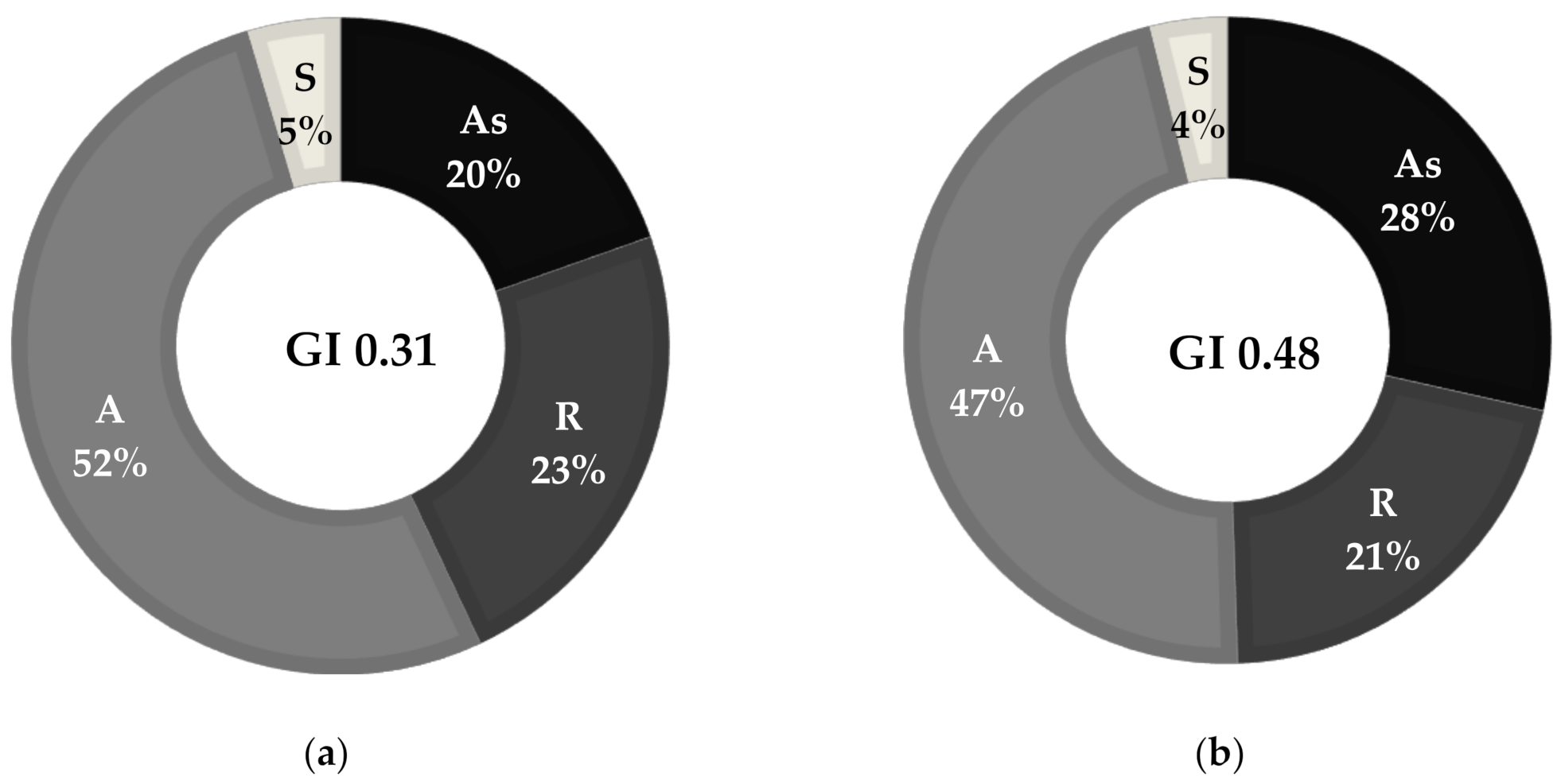

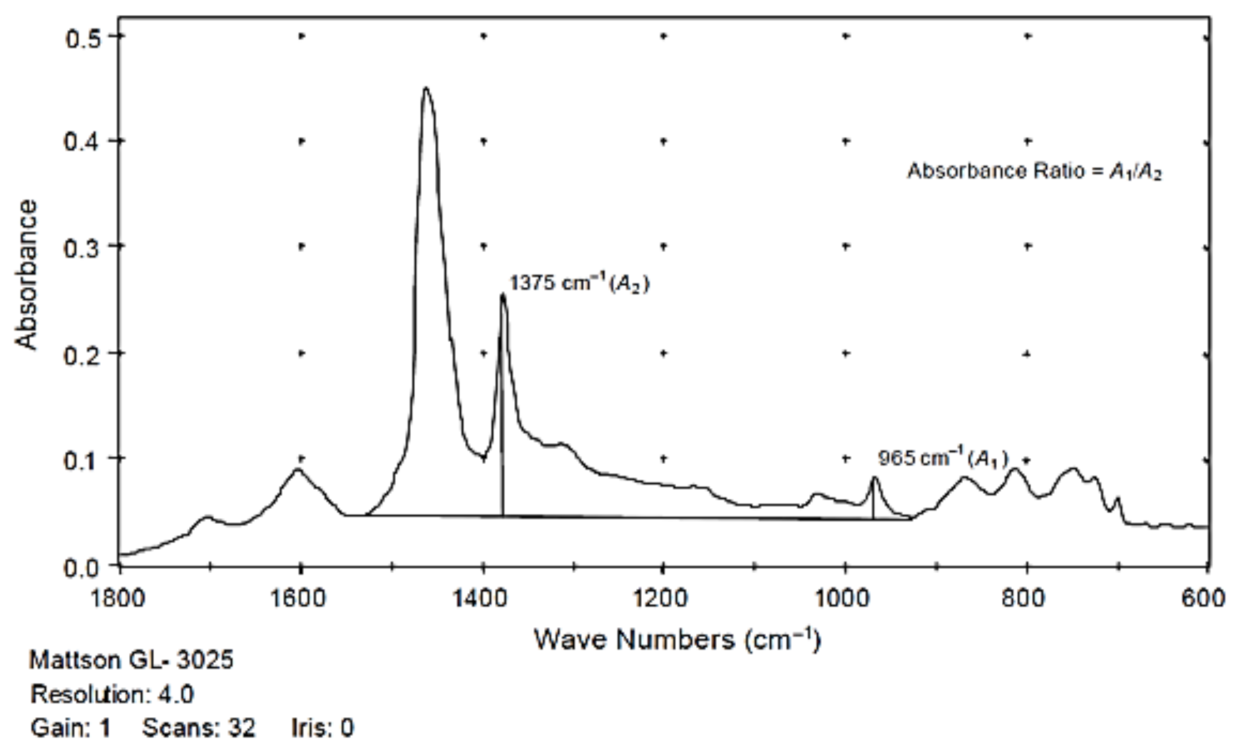
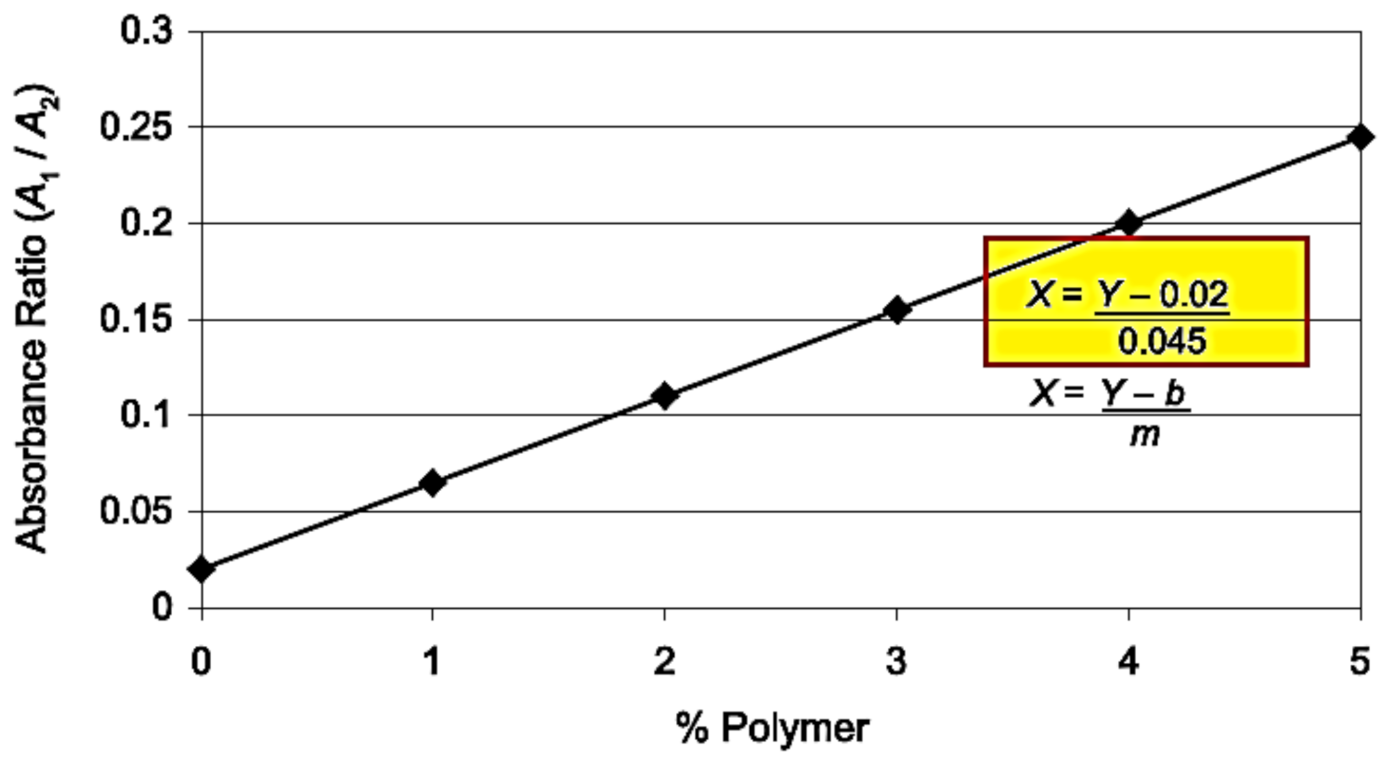
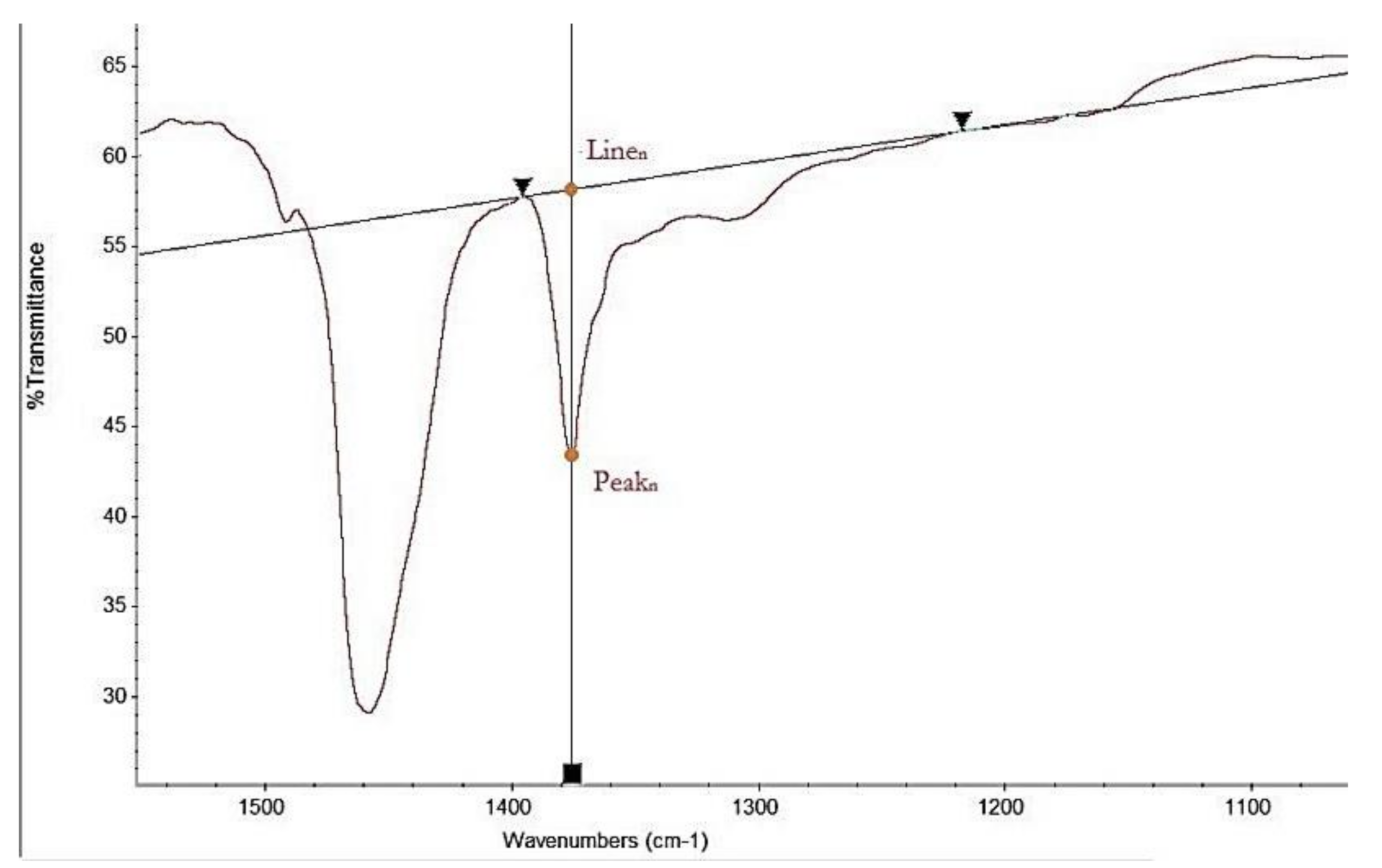
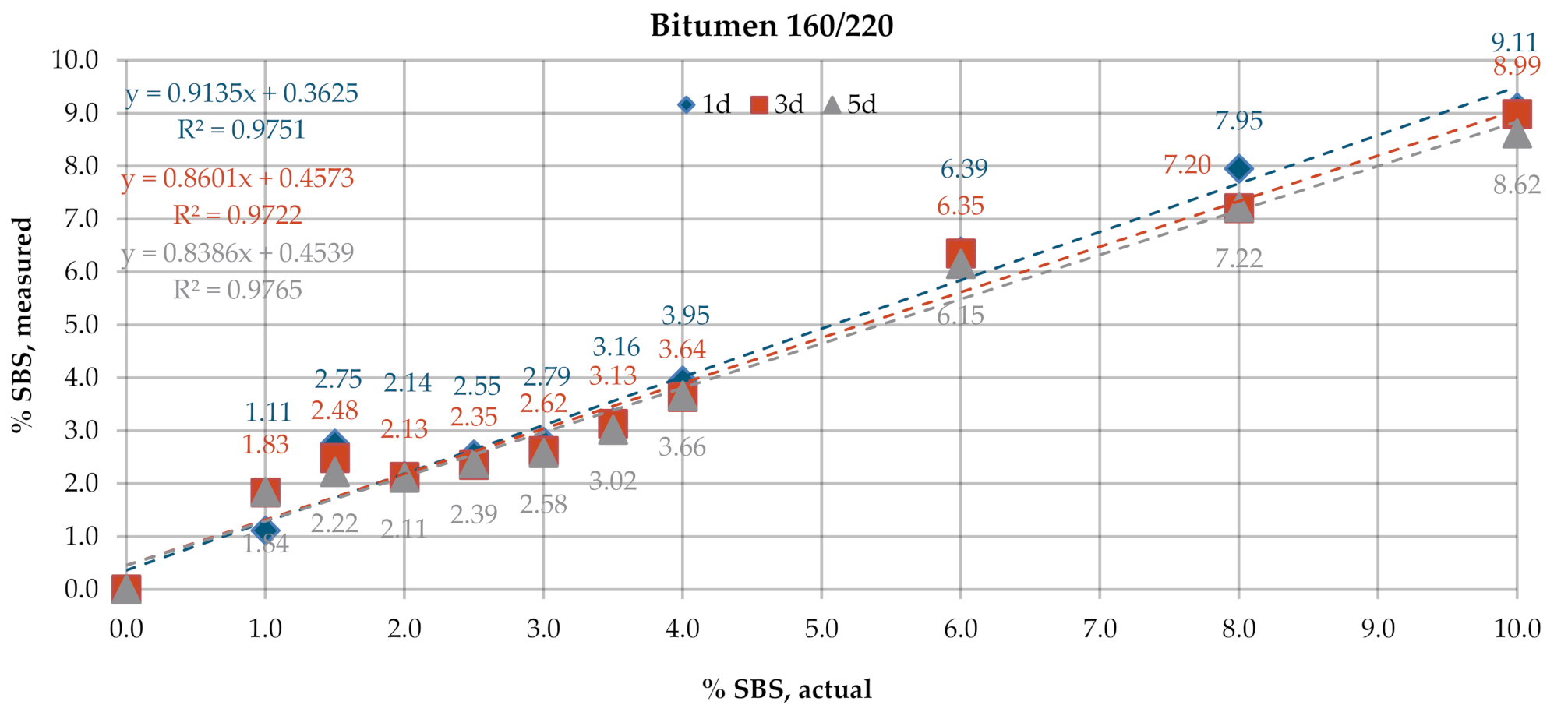
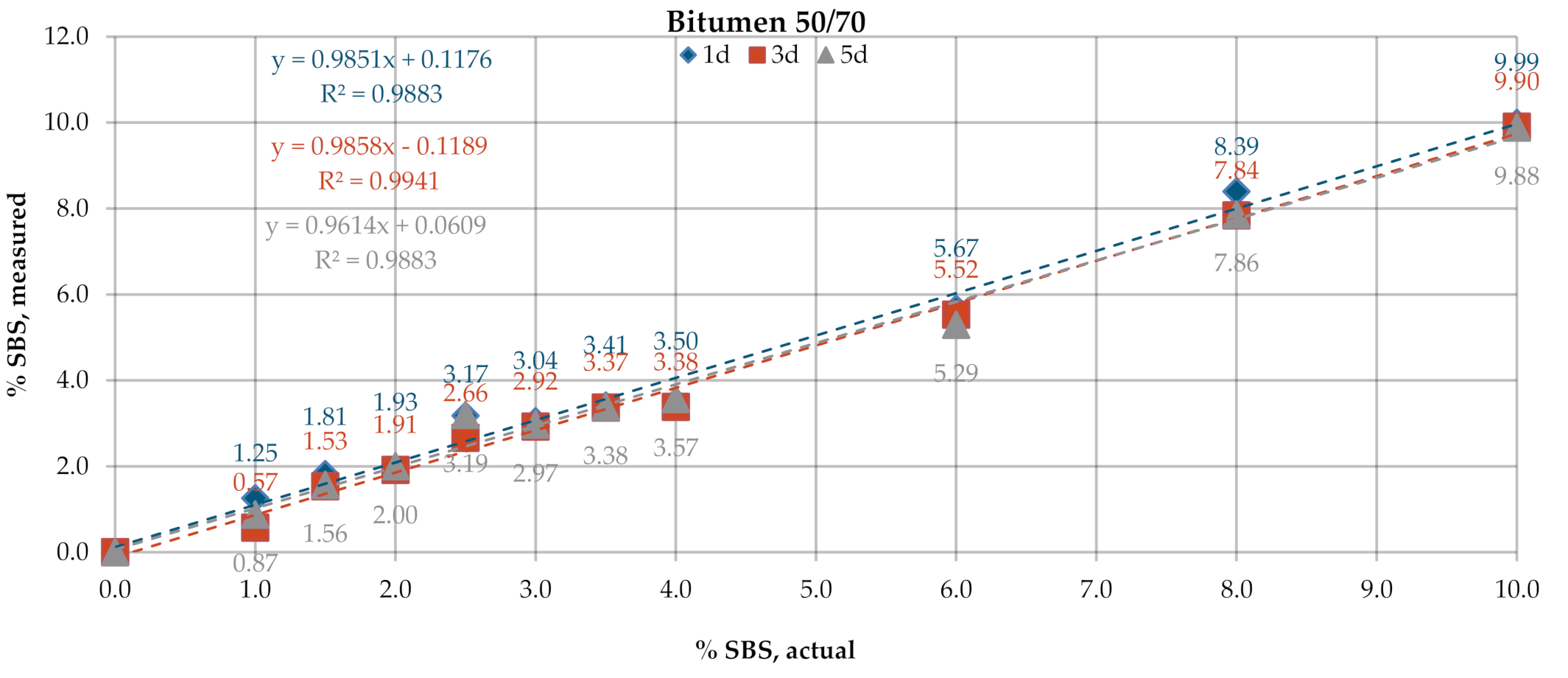
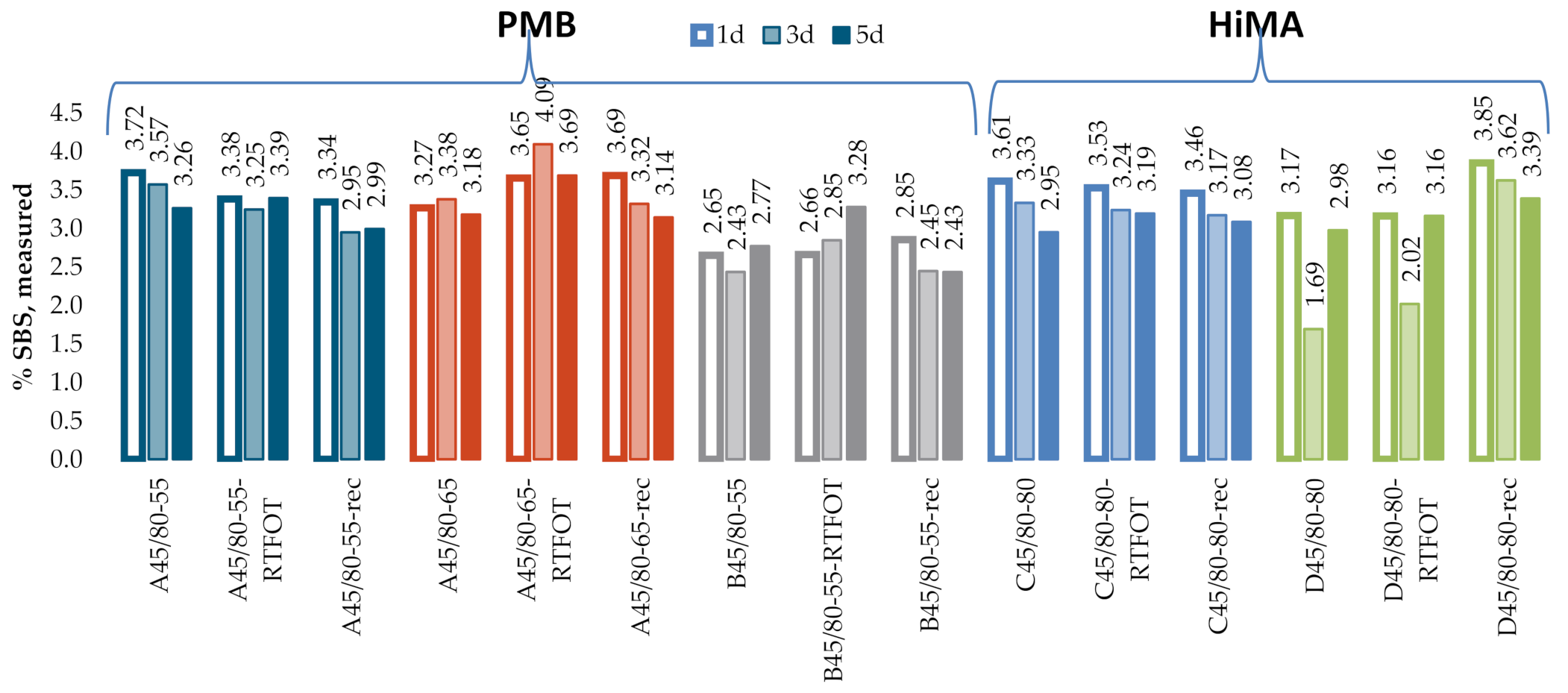
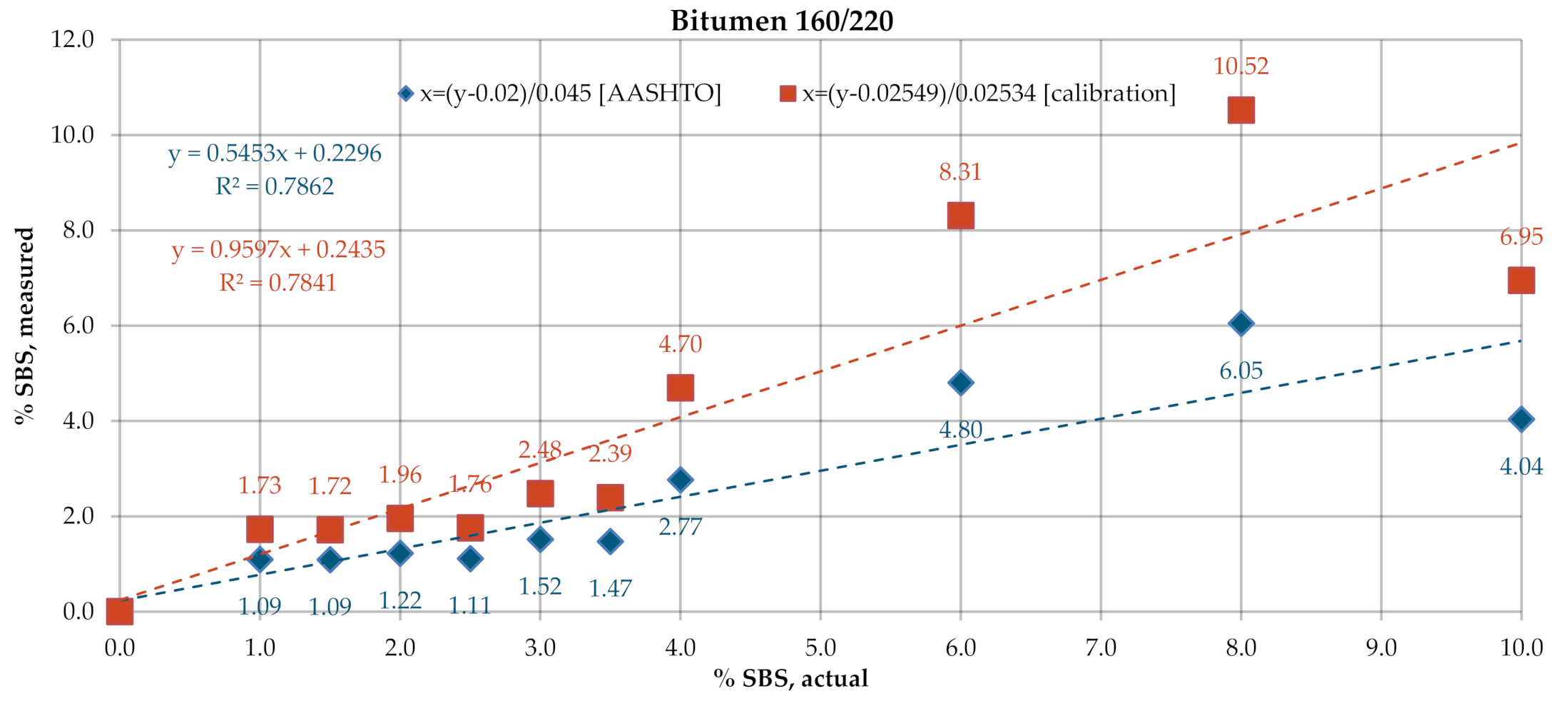
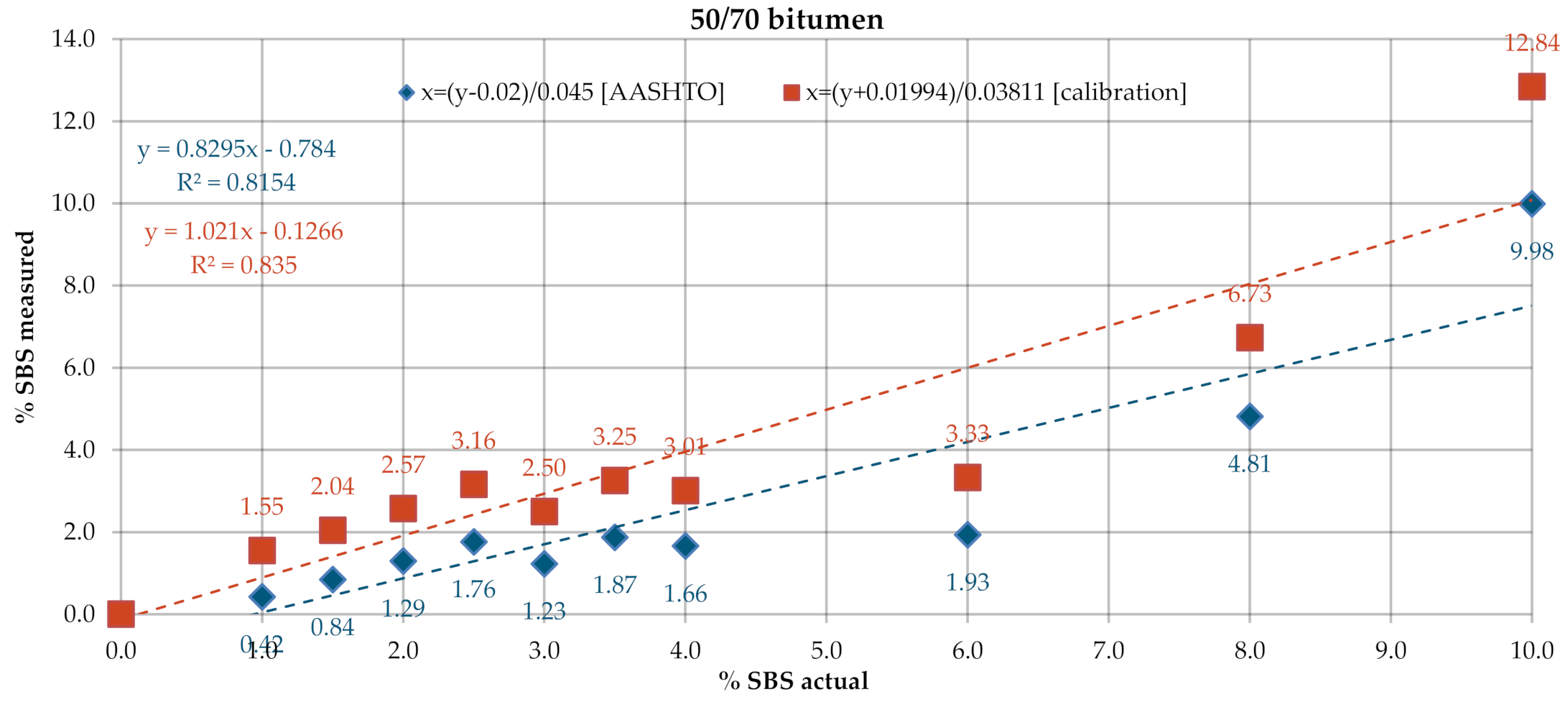

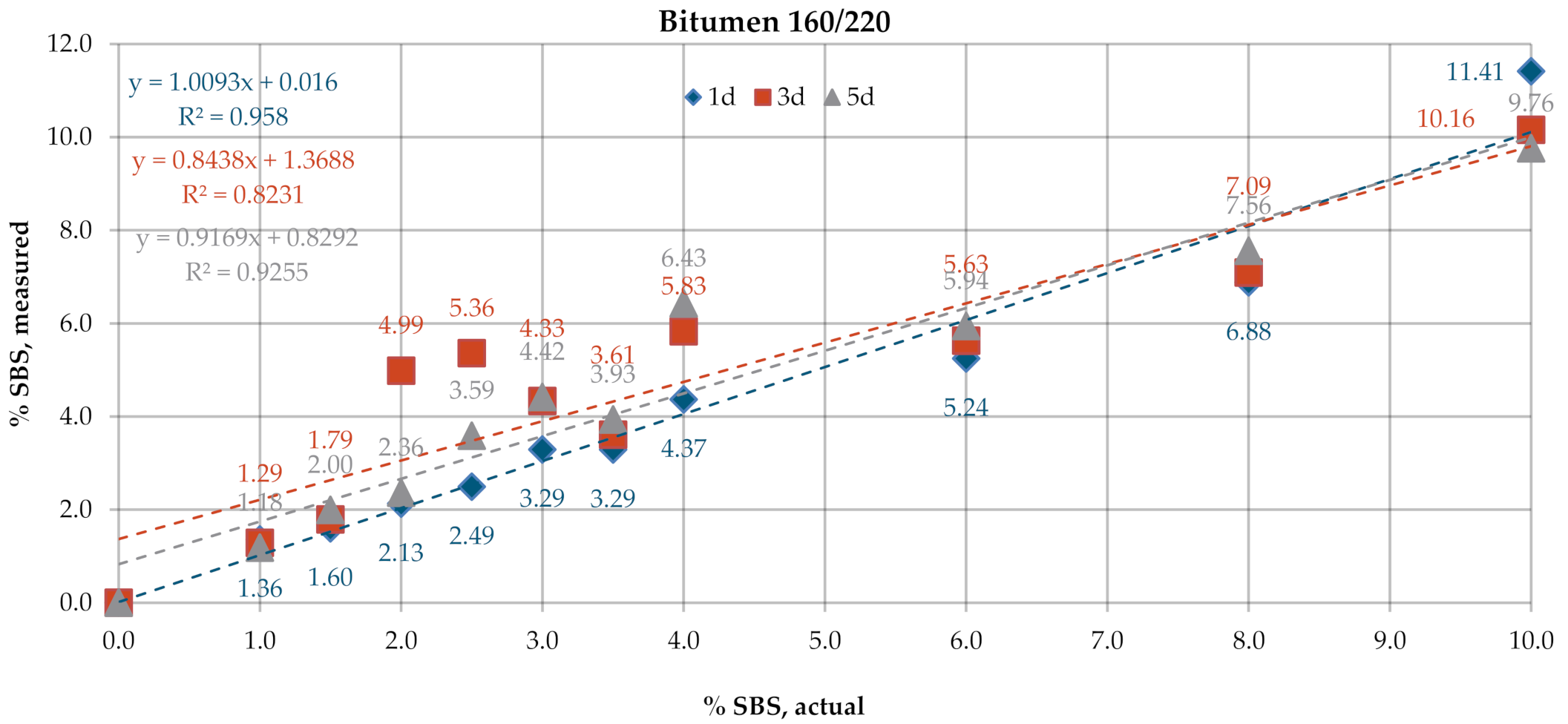

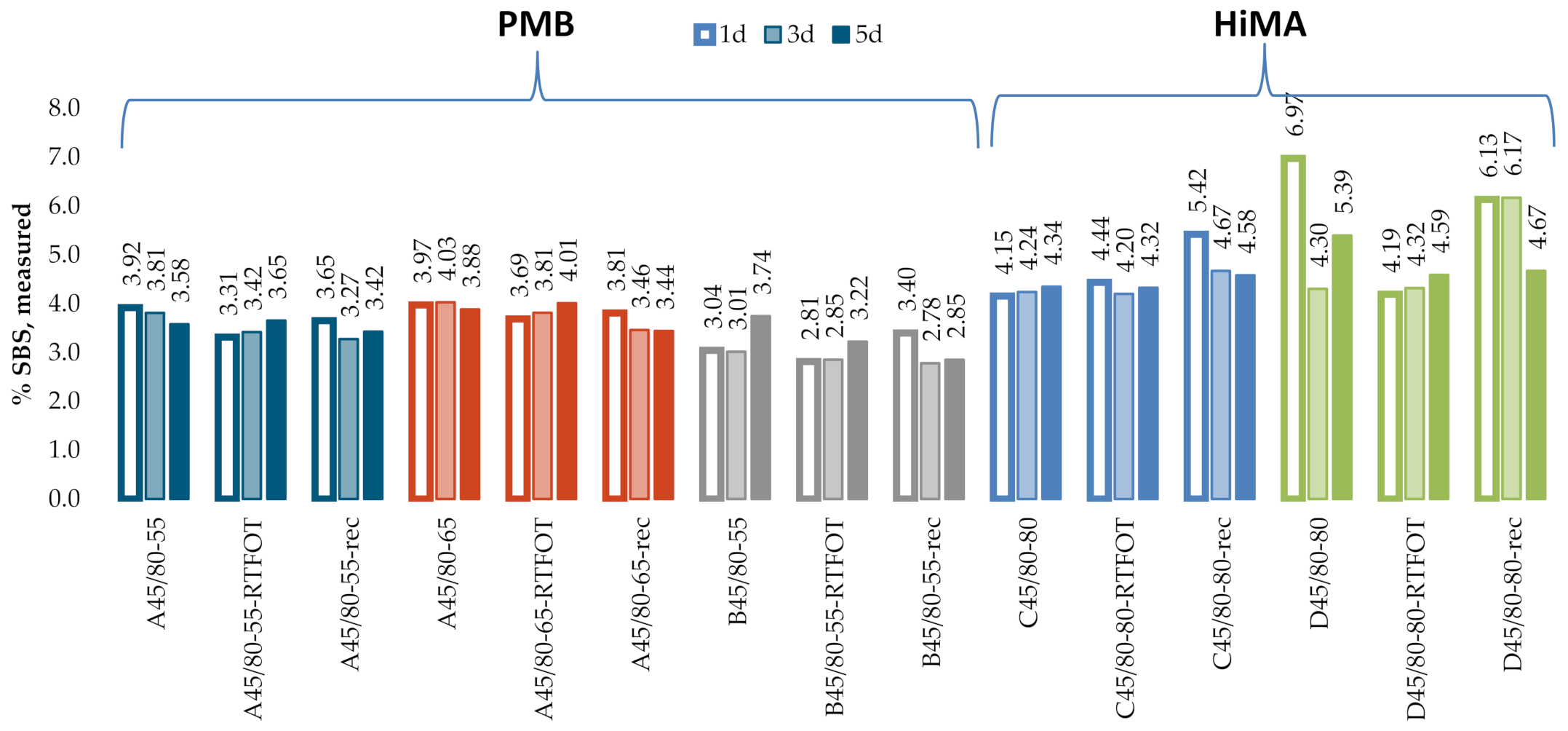
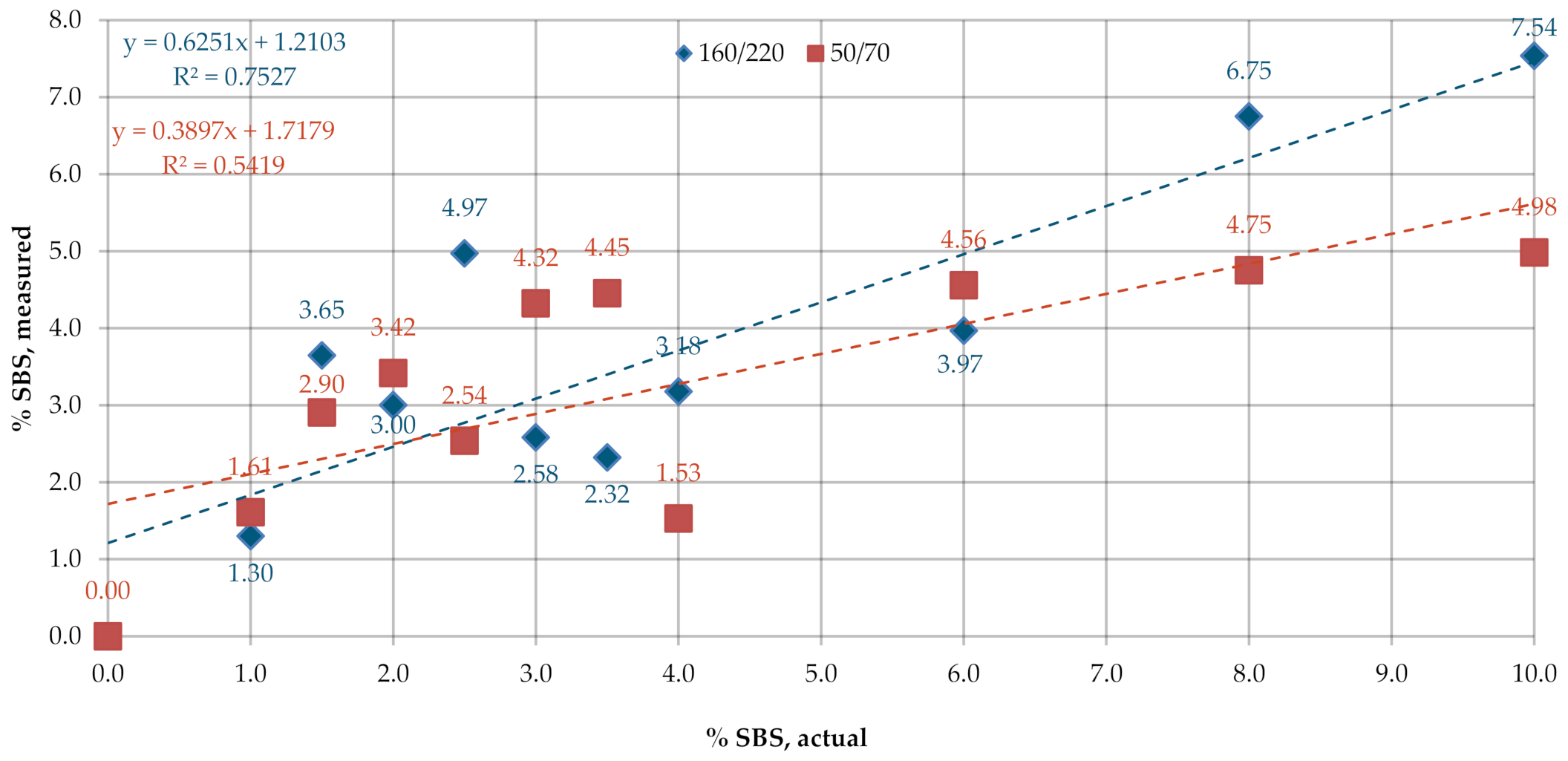
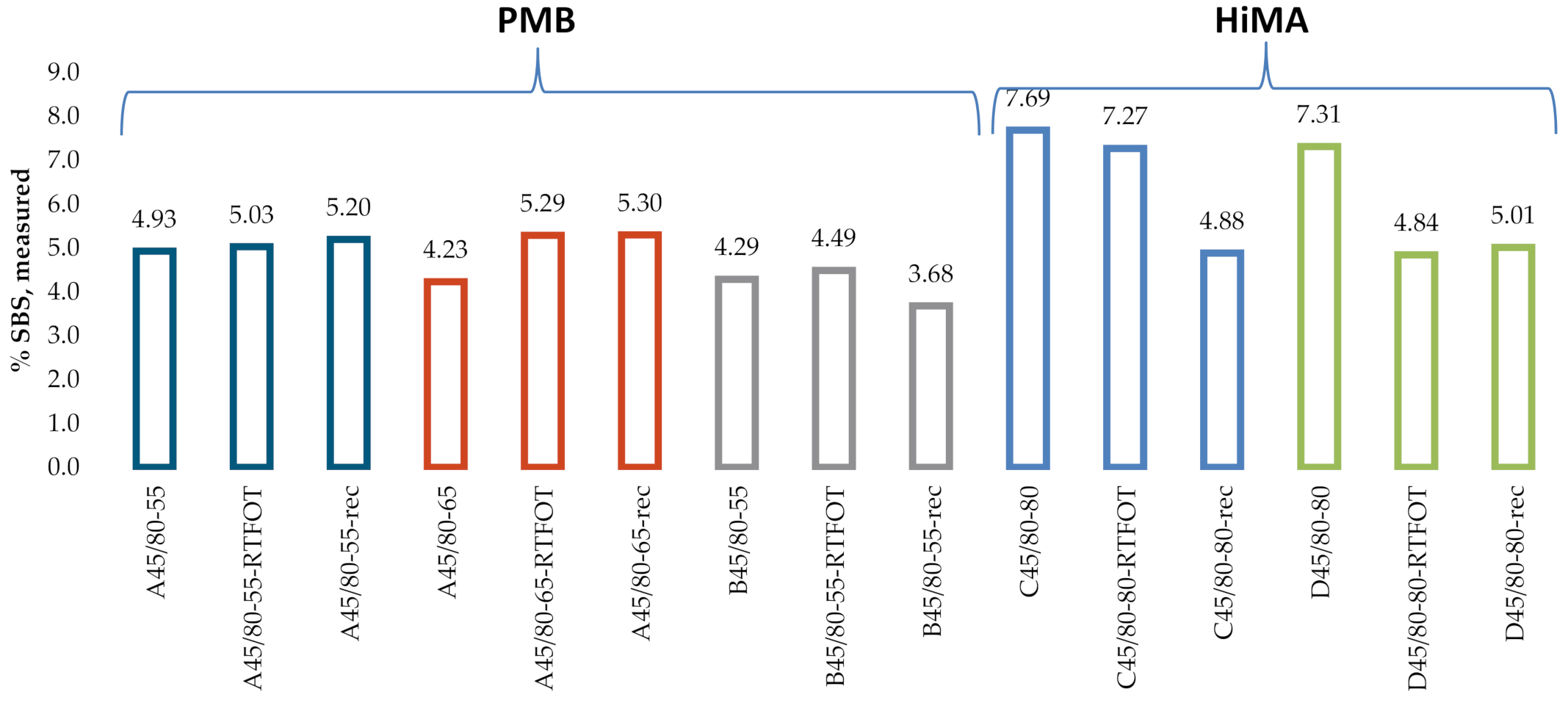
| Type of Bitumen | Softening Point (EN 1427) | Penetration at 25 °C (EN 1426) | Fraass Breaking Point (EN 12593) |
|---|---|---|---|
| - | °C | 0.1 mm | °C |
| 160/220 | 41.0 | 175 | −16.0 |
| 50/70 | 49.6 | 64 | −10.0 |
| Polystyrene Content | Viscosity | Bulk Density | Melting Flow Rate (200 °C/5 kg) |
|---|---|---|---|
| % | Pa·s | kg/dm3 | g/10 min |
| 30 to 32 | 3 to 5 | 0.4 | <1 |
| Tensile Strength | 300% Modulus | Elongation at Break | Hardness, Shore A (30 s) |
| MPa | MPa | % | HShA (30 s) |
| 33 | 2.9 | 880 | 72 |
| Bitumen Type | Symbol | Bitumen Type | Symbol |
|---|---|---|---|
| Lab samples | Industrial samples | ||
| Bitumen 160/220 | 160/220 | PMB 45/80-55 from Manufacturer A | A45/80-55 |
| Bitumen 160/220 modified with 1% of SBS by weigh | 160/220 + 1% SBS | PMB 45/80-55 from Manufacturer A, after simulation of long-term ageing (RTFOT) | A45/80-55-RTFOT |
| Bitumen 160/220 modified with 1.5% of SBS by weight | 160/220 + 1.5% SBS | PMB 45/80-55 from Manufacturer A, recovered from HMA | A45/80-55-rec |
| Bitumen 160/220 modified with 2% of SBS by weight | 160/220 + 2% SBS | PMB 45/80-65 from Manufacturer A | A45/80-65 |
| Bitumen 160/220 modified with 2.5% of SBS by weight | 160/220 + 2.5% SBS | PMB 45/80-65 from Manufacturer A, after simulation of long-term ageing (RTFOT) | A45/80-65-RTFOT |
| Bitumen 160/220 modified with 3% of SBS by weight | 160/220 + 3% SBS | PMB 45/80-65 from Manufacturer A, recovered from HMA | A45/80-65-rec |
| Bitumen 160/220 modified with 3.5% of SBS by weight | 160/220 + 3.5% SBS | PMB 45/80-55 from Manufacturer B | B45/80-55 |
| Bitumen 160/220 modified with 4% of SBS by weight | 160/220 + 4% SBS | PMB 45/80-55 from Manufacturer B, after simulation of long-term ageing (RTFOT) | B45/80-55-RTFOT |
| Bitumen 160/220 modified with 6% of SBS by weight | 160/220 + 6% SBS | PMB 45/80-55 from Manufacturer B, recovered from HMA | B45/80-55-rec |
| Bitumen 160/220 modified with 8% of SBS by weight | 160/220 + 8% SBS | HiMA 45/80-80 from Manufacturer C | C45/80-80 |
| Bitumen 160/220 modified with 10% of SBS by weight | 160/220 + 10% SBS | HiMA 45/80-80 from Manufacturer C, after simulation of long-term ageing (RTFOT) | C45/80-80-RTFOT |
| Bitumen 50/70 | 50/70 | HiMA 45/80-80 from Manufacturer C, recovered from HMA | C45/80-80-rec |
| Bitumen 50/70 modified with 1% of SBS by weight | 50/70 + 1% SBS | HiMA 45/80-80 from Manufacturer D | D45/80-80 |
| Bitumen 50/70 modified with 1.5% of SBS by weight | 50/70 + 1.5% SBS | HiMA 45/80-80 from Manufacturer D, after simulation of long-term ageing (RTFOT) | D45/80-80-RTFOT |
| Bitumen 50/70 modified with 2% of SBS by weight | 50/70 + 2% SBS | HiMA 45/80-80 from Manufacturer D, recovered from HMA | D45/80-80-rec |
| Bitumen 50/70 modified with 2.5% of SBS by weight | 50/70 + 2.5% SBS | ||
| Bitumen 50/70 modified with 3% of SBS by weight | 50/70 + 3% SBS | ||
| Bitumen 50/70 modified with 3.5% of SBS by weight | 50/70 + 3.5% SBS | ||
| Bitumen 50/70 modified with 4% of SBS by weight | 50/70 + 4% SBS | ||
| Bitumen 50/70 modified with 6% of SBS by weight | 50/70 + 6% SBS | ||
| Bitumen 50/70 modified with 8% of SBS by weight | 50/70 + 8% SBS | ||
| Bitumen 50/70 modified with 10% of SBS by weight | 50/70 + 10% SBS | ||
| Parameter | Requirements | Parameter | Requirements |
|---|---|---|---|
| Detector | DTGS KBr | Beam splitter | KBr |
| Source | IR-Turbo | Accessory | Smart orbit |
| Window | Diamond | Gain setting | 8.0 |
| Aperture | 100 | Velocity | 0.6329 |
| Scan range | 1100–625 cm−1 | Number of scans | 32 |
| Test Method 1 | Type of Modifier | Solvent | Peaks | Type of Analysis 2 | Mean Error (Lab Sample) | ||||
|---|---|---|---|---|---|---|---|---|---|
| 1375 | 965 | 911 | 808 | 690 | |||||
| T302–15—T | SBS, SBR, SB | THF | + | + | h | 0.36% | |||
| T302–15—A | SBS, SBR, SB | – | + | + | a | 1.14% | |||
| T521—T | SBS, SBR | Toluene | + | + | + | h | 0.66% | ||
| Q350—A | SBS | CS2 | + | + | + | + | a | 1.60% | |
Publisher’s Note: MDPI stays neutral with regard to jurisdictional claims in published maps and institutional affiliations. |
© 2020 by the authors. Licensee MDPI, Basel, Switzerland. This article is an open access article distributed under the terms and conditions of the Creative Commons Attribution (CC BY) license (http://creativecommons.org/licenses/by/4.0/).
Share and Cite
Ratajczak, M.; Wilmański, A. Evaluation of Laboratory Methods of Determination of SBS Content in Polymer-Modified Bitumens. Materials 2020, 13, 5237. https://doi.org/10.3390/ma13225237
Ratajczak M, Wilmański A. Evaluation of Laboratory Methods of Determination of SBS Content in Polymer-Modified Bitumens. Materials. 2020; 13(22):5237. https://doi.org/10.3390/ma13225237
Chicago/Turabian StyleRatajczak, Maria, and Artur Wilmański. 2020. "Evaluation of Laboratory Methods of Determination of SBS Content in Polymer-Modified Bitumens" Materials 13, no. 22: 5237. https://doi.org/10.3390/ma13225237
APA StyleRatajczak, M., & Wilmański, A. (2020). Evaluation of Laboratory Methods of Determination of SBS Content in Polymer-Modified Bitumens. Materials, 13(22), 5237. https://doi.org/10.3390/ma13225237





